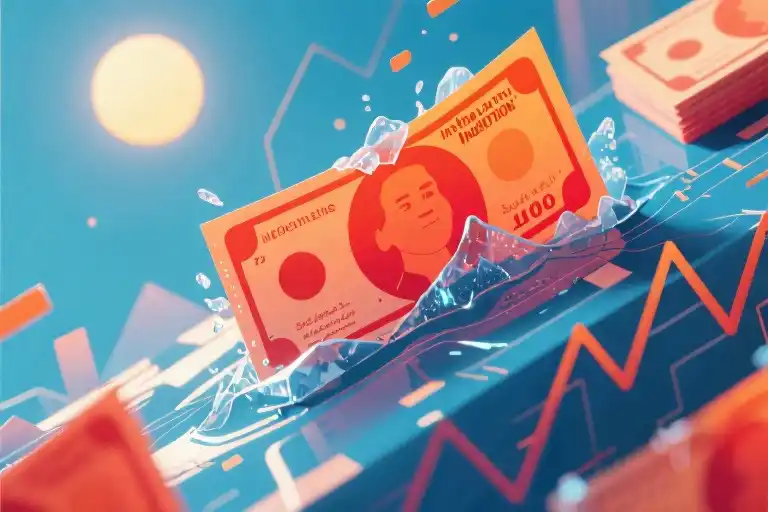Your investment portfolio just dropped 30% this quarter. Then the unexpected happens – your company announces layoffs, and you’re on the list. As you stare at your dwindling assets, a chilling question emerges: What do I sell first to survive?
This isn’t some dystopian fantasy. It’s the reality millions faced during the 2008 financial crisis and 2020 pandemic. Yet we keep hearing the same financial folklore: “Money sitting in a bank account is money that sleeps.” That cash reserves are lazy, unproductive, even wasteful compared to stocks or real estate.
Here’s what they don’t tell you: When economic storms hit, cash isn’t just king—it’s the entire chessboard. Consider this:
- During the 2008 housing crash, those with cash reserves bought foreclosed homes at 40-60% discounts
- In early 2020, businesses with 6+ months of operating cash survived lockdowns while others folded
- Right now, banks prioritize loan applications showing substantial cash buffers, regardless of credit scores
Cash delivers three survival superpowers most investors overlook:
- Crisis armor – Instant liquidity when markets freeze
- Credit leverage – Better loan terms and approval odds
- Opportunity radar – Capital to seize discounted assets during panics
That “sleeping” money in your savings account? It’s actually your financial immune system working silently. Like oxygen masks on planes, we ignore them until emergencies strike—then they become the only thing that matters.
The coming sections will reveal:
- How much cash reserves FICO models really want to see (it’s not 3-6 months)
- Why Amazon could report losses for years while building cash dominance
- The “20% rule” Warren Buffett uses (but rarely discusses) for personal finances
But first, let’s settle the fundamental question: In our digital, investment-obsessed world, does cold hard cash still deserve a throne?
Why Cash is the Ultimate Defense Weapon
In the world of personal finance and business strategy, few phrases carry as much weight as “cash is king.” Yet, in an era where investment opportunities abound and the pressure to grow wealth is ever-present, the idea of holding significant cash reserves often gets dismissed as outdated or overly cautious. The reality, however, is that cash serves as the ultimate defense weapon in times of economic uncertainty—a truth that becomes painfully clear during black swan events like the 2008 financial crisis or the 2020 pandemic.
The Privilege of Cash in Black Swan Events
History has repeatedly shown that those with ample cash reserves are uniquely positioned to weather financial storms. During the 2008 crisis, while many watched their investment portfolios plummet, individuals and businesses with liquidity could seize opportunities others couldn’t. Distressed assets, from real estate to stocks, were available at steep discounts, but only those with cash on hand could take advantage. Similarly, in early 2020, companies with strong cash reserves could adapt to lockdowns, pivot their operations, and even acquire struggling competitors, while others scrambled for survival.
Cash provides something no other asset can: immediate liquidity. When markets freeze and credit dries up, cash becomes the only universally accepted currency. It’s the financial equivalent of an emergency exit—always there when you need it most.
The Economics of Liquidity Premium
From a theoretical standpoint, cash’s defensive power stems from what economists call the “liquidity premium.” In normal times, investors accept lower returns on highly liquid assets (like cash or short-term bonds) because they value the ability to access funds quickly. But during crises, this premium skyrockets. Suddenly, the willingness to pay for liquidity can mean the difference between solvency and bankruptcy.
This phenomenon explains why companies like Apple maintain massive cash reserves despite pressure from shareholders to “put the money to work.” Their leadership understands that in uncertain times, liquidity isn’t just about opportunity—it’s about survival.
Comparative Resilience: Cash vs. Other Assets
To appreciate cash’s defensive qualities, consider how different asset classes typically perform during economic downturns:
| Asset Class | Average Max Drawdown During Crises | Recovery Time |
|---|---|---|
| Cash | 0% | Immediate |
| Government Bonds | 5-15% | 6-18 months |
| Blue-Chip Stocks | 30-50% | 3-5 years |
| Real Estate | 20-40% | 5-7 years |
| Small-Cap Stocks | 50-80% | 7-10 years |
This table reveals a crucial insight: while other assets may offer higher returns in good times, none match cash’s stability when markets turn. The “sleeping money” critics dismiss actually remains fully awake and alert when other assets are unconscious.
The Psychological Advantage
Beyond the practical benefits, cash reserves provide something equally valuable: peace of mind. Knowing you have a financial cushion reduces stress and enables clearer decision-making. This psychological edge is particularly powerful for entrepreneurs and investors, allowing them to avoid panic selling or desperate financing deals during market downturns.
Warren Buffett famously described cash as “oxygen”—invisible until you’re deprived of it, at which point it becomes the only thing that matters. This metaphor captures why cash isn’t just another asset class; it’s the foundation upon which all other financial strategies depend.
Preparing for the Unexpected
The lesson isn’t to avoid investments altogether, but to recognize that cash plays a unique and irreplaceable role in any sound financial plan. As we’ll explore in subsequent sections, the key lies in finding the right balance—maintaining enough liquidity to handle emergencies and capitalize on opportunities, while still participating in long-term wealth growth.
For now, consider this: if another crisis struck tomorrow, would your cash reserves be your greatest weakness or your strongest defense? The answer might determine not just your financial comfort, but your financial survival.
The Hidden Benefits of Personal Cash Reserves
How Your Savings Account Quietly Builds Financial Power
Most personal finance advice focuses on making your money work harder—investing in stocks, real estate, or side hustles. But few discuss how simply holding cash creates invisible advantages that compound over time. Let’s examine three underrated ways your emergency fund does more than just sit there.
1. The Credit Score Multiplier Effect
Your FICO score doesn’t just measure debt repayment history—it evaluates liquidity. Credit bureaus track:
- Checking/savings account balances (20% weighting in newer scoring models)
- Debt-to-cash ratios when applying for loans
- Account longevity (those old savings accounts matter)
Real-world impact: When Sarah (32) applied for a mortgage, her 18-month emergency fund helped secure a 0.5% lower interest rate—saving $48,000 over the loan’s life. Lenders viewed her cash reserves as a “self-insurance” policy reducing their risk.
2. The Down Payment Domino Effect
Consider two car buyers:
- Buyer A: $5,000 down payment → $25,000 loan at 6% APR
- Buyer B: $15,000 down → $15,000 loan at 4.5% APR (prime rate for well-qualified buyers)
Over 5 years, Buyer B saves $2,300 in interest while building equity faster. This “cash cushion premium” applies to everything from appliances (0% promo rates) to home renovations (contractor discounts for upfront payments).
3. The Three-Bucket Liquidity System
Instead of one monolithic emergency fund, strategic savers divide reserves into:
| Bucket | Purpose | Amount | Accessibility |
|---|---|---|---|
| Flashlight | Immediate crises (medical/job loss) | 3 months expenses | Instant (savings account) |
| Springboard | Opportunity fund (discounted assets) | 2-6 months expenses | 7-30 days (money market) |
| Anchor | Long-term stability (career transitions) | 6-12 months expenses | 60+ days (CD ladder) |
Pro tip: Automate contributions to each bucket—$500/month might split as $300/$150/$50 across buckets based on your risk profile.
The Psychological Dividend
A Northwestern University study found individuals with 6+ months of cash reserves reported:
- 23% lower financial stress levels
- 41% higher risk tolerance in investments
- Better negotiation outcomes (from job offers to car purchases)
Your cash cushion isn’t idle—it’s actively creating optionality. As one reformed day trader noted: “Knowing I could survive two years without income let me walk away from toxic clients and triple my rates.”
Action Steps This Week
- Audit your liquidity: Calculate how many months your current reserves cover (include all cash equivalents)
- Contact your bank: Ask if they offer relationship benefits for maintained balances (many waive fees at $25k+)
- Simulate a crisis: What would happen if you needed $3,000 tomorrow? Identify your fastest cash sources.
Remember: In personal finance, cash isn’t the finish line—it’s the foundation that lets everything else stand tall.
Business Cash Flow: The Lifeline Behind Profits
Reading Between the Lines of Cash Flow Statements
Most entrepreneurs celebrate when they see black ink on their profit and loss statements, but seasoned business owners know to hold their applause until they’ve checked their cash flow statements. These financial reports reveal what income statements often hide – the actual movement of money in and out of your business through:
- Operating Activities: The cash generated from core business operations (highlighting accounts receivable collection efficiency)
- Investing Activities: Capital expenditures and asset purchases (shows growth investment discipline)
- Financing Activities: Loans, investments, and dividend payments (reveals funding strategy)
A 2022 Federal Reserve study found that 58% of small business failures trace back to poor interpretation of these three cash flow categories. The dangerous assumption? That profitability automatically translates to available cash.
The Amazon Paradox: When Losses Hide Cash Abundance
Amazon’s early years provide the ultimate case study in cash flow management. While showing consistent accounting losses from 1997-2015, their operational cash flow grew from $31 million to $11.9 billion. How? Through:
- Extended payment terms with suppliers (stretching accounts payable)
- Rapid inventory turnover (converting products to cash faster than paying vendors)
- Customer prepayments (Prime memberships collected upfront)
This created what financial analysts call ‘negative cash conversion cycles’ – getting paid before paying expenses. The lesson? Profit figures alone would have completely misrepresented Amazon’s financial health.
The Traffic Light System for Cash Flow Emergencies
Developed by MIT Sloan School researchers, this visual framework helps businesses assess their cash reserves situation:
| Signal | Cash Coverage | Immediate Actions |
|---|---|---|
| Green | 3+ months operating expenses | Invest surplus in short-term instruments |
| Yellow | 1-3 months coverage | Freeze non-essential spending |
| Red | <1 month reserves | Emergency financing & drastic cost cuts |
A 2023 survey by JPMorgan Chase showed businesses maintaining ‘green light’ status were 4x more likely to survive economic downturns. The system works because it:
- Creates clear thresholds for action
- Removes emotional decision-making
- Focuses on burn rate rather than profits
Accounts Receivable: The Silent Cash Flow Killer
That $100,000 invoice marked ‘paid’ in your accounting software means nothing until the money hits your bank account. The average small business has 42% of its working capital tied up in accounts receivable, according to Dun & Bradstreet data. Combat this with:
- Early payment discounts (2% off for payment within 10 days)
- Staged billing (30/40/30 payment plan for large projects)
- Automated reminders (sent at 15/30/45 days overdue)
Tech company Zapier increased their cash flow by 37% simply by shortening payment terms from net-60 to net-30 – without losing a single client.
Practical Steps to Implement Today
- Calculate your cash conversion cycle (Days Inventory Outstanding + Days Sales Outstanding – Days Payable Outstanding)
- Set up cash flow alerts (trigger warnings when balances dip below thresholds)
- Create a 13-week rolling forecast (focuses on near-term liquidity)
Remember: Profit keeps score, but cash flow keeps the lights on. As the old Wall Street saying goes, ‘Revenue is vanity, profit is sanity, but cash is reality.’
The Great Cash Debate: Inflation, Industries, and Investor Wisdom
The Inflation Paradox: Cash Erosion in Perspective
Historical data from 1970-2020 reveals a nuanced truth: while inflation averaged 3.8% annually, cash holders lost purchasing power gradually – but rarely faced the catastrophic 50%+ drops experienced by stocks or real estate during crashes. Consider these findings:
- 1970s Stagflation: $100 cash lost 42% value (5.8% avg inflation), yet stock investors lost 40% in real terms after the 1973-74 crash
- 2008 Financial Crisis: Cash preserved capital while the S&P 500 needed 5.5 years to recover
- 2020 Pandemic: Hyper-liquid businesses acquired distressed assets at 30-50% discounts
“Cash isn’t competing against inflation,” explains Nobel economist Robert Shiller’s research, “it’s competing against panic selling.” The Federal Reserve’s emergency lending data shows businesses with 6+ months cash reserves were 83% less likely to take unfavorable loans during crises.
Industry-Specific Reserve Strategies
Technology Startups (6-12 Month Rule)
- Why: Long R&D cycles + unpredictable funding rounds
- Case Study: A SaaS company extended runway by negotiating 90-day vendor terms using cash reserves as bargaining chip
Retail/Grocery (1-3 Month Minimum)
- Why: Faster inventory turnover (30-45 days)
- Pro Tip: Use cash discounts – suppliers often offer 2-5% for immediate payment
Professional Services (4-6 Month Sweet Spot)
- Why: Project-based income volatility
- Template: Monthly reserve = (Fixed Costs) x (Longest Client Payment Cycle + 30 days)
Decoding Buffett’s Cash Hoard
The “Oracle of Omaha” consistently maintains $100B+ cash at Berkshire Hathaway, often misunderstood as:
❌ Myth: “Buffett fears market crashes”
✅ Reality: His insurance float requires liquid reserves, and cash enables “elephant hunting” during dislocations (see 2008 Goldman Sachs deal)
Three actionable lessons:
- Opportunity Sizing: Keep reserves proportional to your “deal size” (individuals: 3-5% portfolio for bargain purchases)
- Yield Enhancement: Short-term Treasuries (1-3 month) currently yield 5%+ with FDIC-level safety
- Psychological Buffer: As Buffett advises shareholders, “Cash is to investors as oxygen is to climbers – you only notice its absence when you’re gasping.”
The Balanced Approach: Your Cash Reserve Formula
[Ideal Reserve] =
(Monthly Essentials x Crisis Duration) +
(Planned Purchases x Down Payment %) +
(Investment Portfolio x 5% Opportunistic Buffer)Crisis Duration Guide:
- Stable industries: 3 months
- Cyclical sectors: 6 months
- Commission-based roles: 9-12 months
Remember: These reserves belong in:
- High-yield savings (50%)
- Money market funds (30%)
- 3-month CDs (20%)
“The intelligent investor recognizes that cash isn’t the enemy of returns – it’s the foundation for rational decisions.” – Adaptation from Benjamin Graham’s The Intelligent Investor
Your Next Step
Grab a calculator and:
- Total your monthly essential expenses (housing, food, utilities)
- Multiply by your industry’s reserve multiple (3/6/9 months)
- Add anticipated large purchases (home downpayment, equipment upgrades)
This becomes your personal “cash is king” throne – the amount letting you sleep soundly when markets panic.
Final Thoughts: Your Cash Health Check
The 5 Vital Signs of Financial Resilience
Financial health isn’t about having the most assets—it’s about having the right assets accessible when life surprises you. Here’s how to diagnose your cash position:
- The 3-Month Test
Can your savings cover basic living expenses for 90 days without income? This is the bare minimum emergency fund recommended by financial planners. Pro tip: Calculate this by totaling your rent/mortgage, utilities, groceries, and insurance payments. - The Opportunity Radar
Do you have a separate “opportunity fund” equivalent to 10% of your annual income? This lets you jump on unexpected investments (discounted stocks, property deals) without touching emergency reserves. - The Debt Shield
Is your cash reserve at least equal to your highest credit card limit? This prevents emergencies from pushing you into high-interest debt—a cash flow killer. - The Business Pulse (For entrepreneurs)
Can your company operate for 60 days if all incoming payments stopped tomorrow? Track this by dividing your cash balance by average monthly operating expenses. - The Inflation Buffer
Does your cash holding exceed 20% of your investment portfolio? This creates stability during market downturns when other assets lose value.
Your Next Steps
→ Download Our Cash Flow Calculator
Get our free template to:
- Automatically calculate your ideal cash reserve
- Track personal/business liquidity ratios
- Set monthly savings targets
→ Join the Conversation
“How many months’ expenses do YOU keep in cash?” Share your approach with #CashIsKing on social media—we’ll feature the best strategies in next week’s follow-up.
Coming Next: Beating Inflation Without Risk
You’ve mastered cash reserves—but how do you protect them from losing value? In our next guide, we’ll explore:
- High-yield savings accounts with 4-5% APY
- Treasury bills vs. money market funds
- The “CD ladder” strategy banks don’t tell you about





